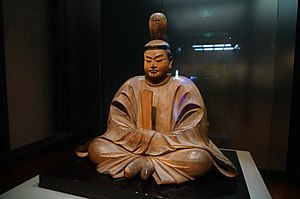
Back هاتشيمان Arabic Hachiman Catalan Hachiman German Χατσίμαν Greek Hachiman Spanish Hachiman Basque هاچیمان Persian Hachiman Finnish Hachiman French Hacsiman Hungarian

In Japanese religion, Yahata (八幡神, ancient Shinto pronunciation) formerly in Shinto and later commonly known as Hachiman (八幡神, Japanese Buddhist pronunciation) is the syncretic divinity of archery and war,[1][2][3] incorporating elements from both Shinto and Buddhism.[4]
The first mention of this kami is found in the Shoku Nihongi as it contains the information that offerings were sent 794 CE to Hachiman shrines on the occasion of conflict with the kingdom Silla in Korea.[5]
In Shinto religion, he is mortally Emperor Ōjin (応神天皇, Ōjin Tennō) by birth who reigned in the 3rd–4th century and the son of Empress Jingū (神功皇后, Jingū-kōgō), later became deified and identified by legend as "Yahata-no-kami" meaning "Kami of Eight Banners", referring to the eight heavenly banners that signaled the birth of the divine and deified emperor, and is also called Hondawake (誉田別命). His messenger is the dove, symbolizes both the bow and arrow found in samurai banners associated to him where he is called "Yumiya Hachiman" (弓矢八幡).
Since ancient times Hachiman has been worshiped by farmers as the god of agriculture and by fishermen, who hoped that he would fill their nets with many fish.
During the age of the samurai, descendants of both samurai clans, Seiwa Genji (清和源氏 Seiwa Gen-ji, a line of the Minamoto clan descended from Emperor Seiwa) and Kanmu Taira (桓武平氏 Kanmu Taira'u-ji/ Hei-shi/ Hei-ji, a line of the Taira clan descended from Emperor Kanmu) honored Hachiman, from which the tradition is derived nationwide in which samurai clans (武家 "buke" in Japanese) honor Hachiman as the deity sacred to them. His other roles include determining a samurai's fate—i.e., whether they are a success or failure in battle; controlling and protecting the martial arts; and proclaiming the victory of an army.
Although often called the god of war, he is more strictly defined as the tutelary god of warriors.[4][6] He is also the divine protector of Japan, the Japanese people and the Imperial House.
- ^ Kanda, Christine Guth (1 July 1985). Shinzō: Hachiman Imagery and Its Development. Harvard East Asian Monographs. Vol. 119 (1st ed.). Harvard University Asia Center, Harvard University. doi:10.2307/j.ctt1tg5jkx.
- ^ Law, Jane Marie (1994). "Violence, Ritual Reenactment, and Ideology: The "Hōjō-e" (Rite for Release of Sentient Beings) of the USA Hachiman Shrine in Japan". History of Religions. 33 (4): 325–357. ISSN 0018-2710.
- ^ "Hachiman & Hachimangū Shrines".
It was only later, sometime in the 9th century, that the deity became associated with Emperor Ōjin, and later still that Hachiman became worshipped as the god of archery and war, ultimately becoming the tutelary deity of the Minamoto clan and its famed warrior Minamoto Yoritomo 源頼朝 (1147–99), founder of the Kamakura shogunate
- ^ a b Scheid, Bernhard. "Hachiman Shreine" (in German). University of Vienna. Retrieved 17 August 2010.
- ^ Picken, Stuart (1994): Essentials of Shinto: An Analytical Guide to Principle Teachings. Green Wood Press, Westport. P. 103.
- ^ Motegi, Sadazumi. "Shamei Bunpu (Shrine Names and Distributions)" (in Japanese). Encyclopedia of Shinto. Retrieved 23 March 2010.
© MMXXIII Rich X Search. We shall prevail. All rights reserved. Rich X Search